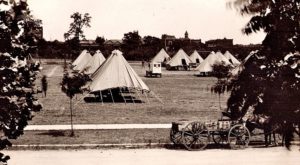The Seventh Texas Infantry Regiment was a unit of volunteers in the National Guard. It was mustered into state service in early July, 1917. By the end of July the Seventh Texas was fully recruited and ready to begin basic training. The problem was that their training camp, Camp Bowie in Fort Worth, hadn’t been built yet.
Company A
Company A of the Seventh Texas, Captain Thomas D. Barton commanding, was located in Amarillo. In August 1917 Amarillo was a city on its way to a population of 15,000. It was a rail transportation center served by the Santa Fe Railroad, the Fort Worth & Denver City Railroad and the Rock Island Line. Live cattle, and meat from Amarillo’s packing industry were sent north to Kansas City, St. Louis and Chicago on the rails.
The men of Company A were gathered from Amarillo and the surrounding counties in the Texas panhandle. They worked on ranches, farms and railroads. Some of them were skilled workers at factories and railroad workshops. Others were clerical workers from the city. A few were fresh out of school.
Company A gathered frequently in Amarillo during July to practice military drill. They had no uniforms or weapons. There were three officers. Moreover they had no barracks, and attendance at drill was not yet mandatory. Building an American army in 1917 was a matter of hurry up and wait. Meanwhile, in Fort Worth, Camp Bowie was being built at a furious pace by 3,500 laborers and builders. The recruits of Company A would have to start their training at home.

In fact, all fifteen companies of the Seventh Texas trained at home during July-August of 1917. They stayed at fairgrounds, schools, warehouses, garages and homes. Amarillo’s Company A had a slightly better deal. The Lowrey-Phillips School north of the city was a military high school for boys when it closed after spring term in 1917. Newly vacant, Captain Barton and Company A moved right in. They renamed it Camp Bloor after the Seventh Texas’ commanding officer, Col. Alfred Bloor.
Life in Camp
Once in camp, life for the boys of Company A became more disciplined. Morning drill came before breakfast. The company became used to running and long marches. For example, one day in August, Captain Barton led the men to Canyon, Texas, nineteen miles south, for lunch. When they were not busy at drill, the men attended lectures on “sanitation, personal hygiene and military courtesy”.
The Amarillo community got into the act. Amarilloans and people in the surrounding communities sent books, sports equipment and toiletries to Camp Bloor. In addition, local homes sponsored soldiers after church services for Sunday afternoon dinner that summer of 1917.
In other communities across the Texas panhandle local companies were part of town square dances and baseball games. Every community pitched in to support their local soldiers. In early August the Seventh Texas Infantry was drafted into Federal service along with the rest of the Texas National Guard. They were surely fighting for Uncle Sam now and, for the first time, getting paid.
Coming together
Close to the end of their stay in Amarillo, Captain Barton marched the men of Company A down Polk Street where they stopped in front of the theater for inspection. After that, the whole company went to the movies for free. Soon thousands of men from towns and small cities across Texas would make their way to Camp Bowie to be formed as a larger unit. However during that summer, local companies had to make do with the unit they had. Historian George Ball observed about that summer:
“Indeed, for the Seventh Texas, the brief period in August 1917 while they waited to move was really the only time the regiment was what it was recruited to be: a Texas National Guard unit filled with Texas soldiers and commanded by Texas officers, all of whom were from the same or nearby communities.”
You can read about Company I, Seventh Texas Infantry, during a similar stay in Abilene here.


